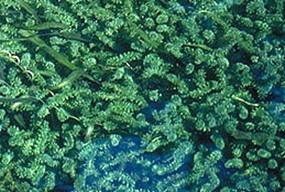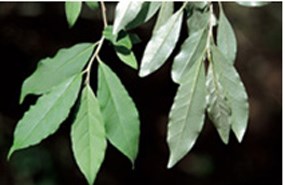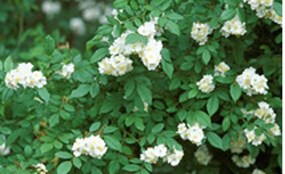|
A number of invasive plants have taken root at the Obed Wild and Scenic River. Invasive species have also become prevalent along the park's boundaries. The plants listed below particularly concern the park's resource management staff. 
Hydrilla An aquatic plant known as hydrilla (Hydrilla verticillata) has been found in the park's waters since August 2007. Growing rapidly, this invasive plant can quickly dominate native vegetation, forming dense mats at the surface of the water and dramatically altering the balance of the aquatic ecosystem. Hydrilla covers spawning areas for native fish and can also cause significant reductions in stream oxygen levels. Hydrilla also limits human uses of streams. Hydrilla-choked channels can make recreational activities, such as swimming, fishing, or wading difficult or impossible. Hydrilla is currently present in Daddy's Creek, in the Obed River below its confluence with Daddy's Creek, and in the Emory River below its confluence with the Obed. Park management is currently evaluating what can be done to limit the spread of this aggressive plant. View a USDA website for more information. 
Autumn Olive Autumn olive (Elaeagnus umbellata) is a fast-growing invasive exotic shrub. It was introduced from China and Japan in the mid 1800s to be planted for wildlife food and surface-mine reclamation. Autumn olive grows to approximately 20 feet in height with scattered thorny branches. It has alternate leaves that are green above and silver beneath with many red berries forming in fall. This species of plant is spread by bird- and mammal-dispersed seeds. Due to the silvery underside of the foliage, this plant is easily visible in open forests and on forest edges and roadsides. Park botanists at Obed continue to combat this invasive plant as it threatens native vegetation by invading rare and unique plant ecosystems. Learn more on a Center for Invasive Species and Ecosystem Health website.

Mimosa Mimosa (Albizia julibrissin) is an exotic tree that can reach a height of 40 feet. This invasive species reproduces by abundant seed production and root sprouts. Mimosa, traditionally planted as an ornamental, has plentiful showy pink and white flowers throughout the summer that yield dangling flat seed pods often retained during winter. The tree has feathery leaves resembling a fern with smooth light-brown to grayish bark. Seedpods float and spread along the waterways of the Obed River system and can remain viable for many years. Boaters can spot this tree easily from the Obed's waterways. Park employees are working to keep the Obed's riparian areas free of this invasive species to help promote the unique native ecosystem near the rivers intact. View a Plant Conservation Alliance website for more information.

Multiflora Rose Multiflora rose (Rosa multiflora) is an invasive exotic species found at the Obed and its tributaries. It was introduced from Asia and traditionally planted as an ornamental, livestock containment, and wildlife habitat. This invasive species was widely planted as "living fences" or screening. Multiflora rose has long arching or climbing stems with many curved thorns. In the spring it forms clusters of white flowers composed of 5 petals with many yellow anthers in the center. It colonizes prolifically by sprouting, stems that take root, and by animal dispersal. This invasive exotic rose often spreads along right-of-ways, new forests, and forest edges. It is easily noticed by its dense infestations often climbing nearby trees. Multiflora rose resembles native species of rose which have pink flowers in spring. Another identifying characteristic of multiflora rose is the bristled leafstalks located at the base of each leaf. Multiple methods of eradication have been used on multiflora rose by the employees of the Obed Wild and Scenic River to prevent this invasive species from crowding out native species. View a USDA website for more information.
|
Last updated: December 23, 2020
